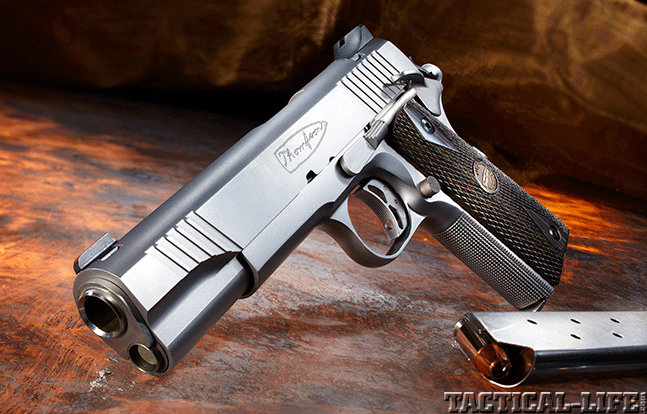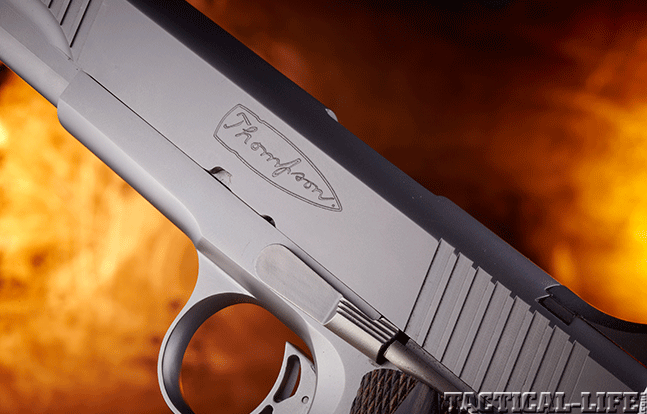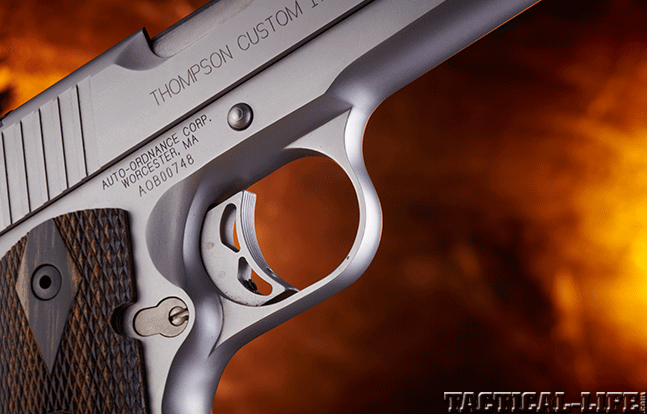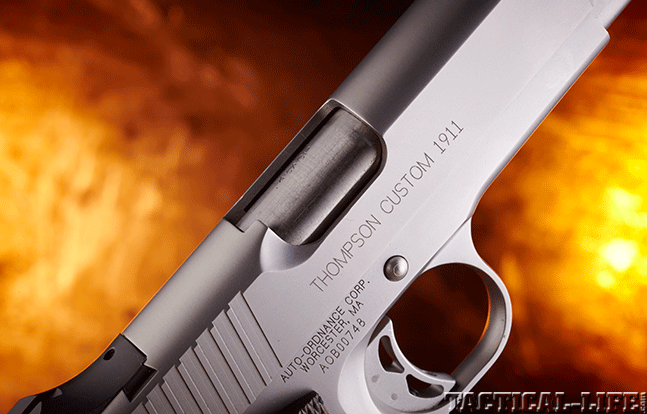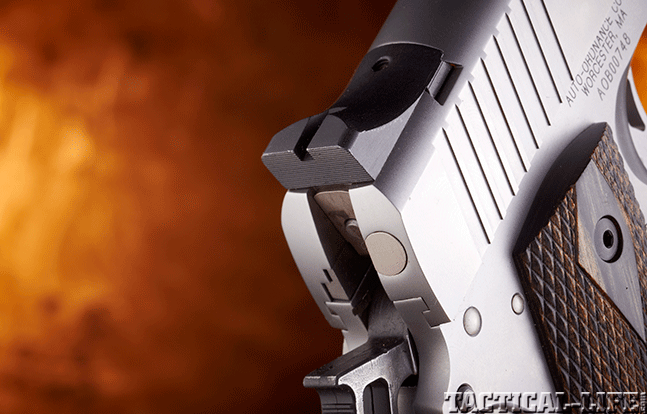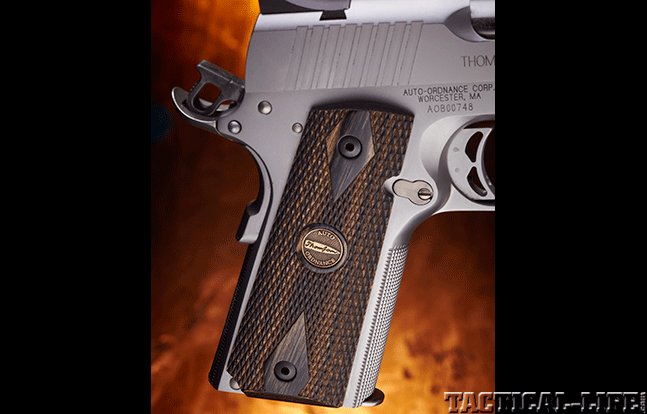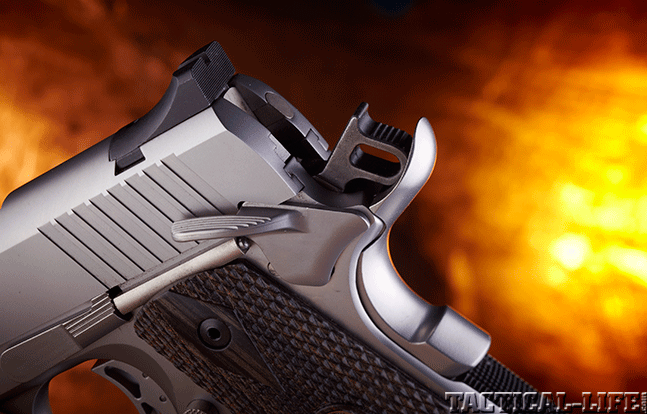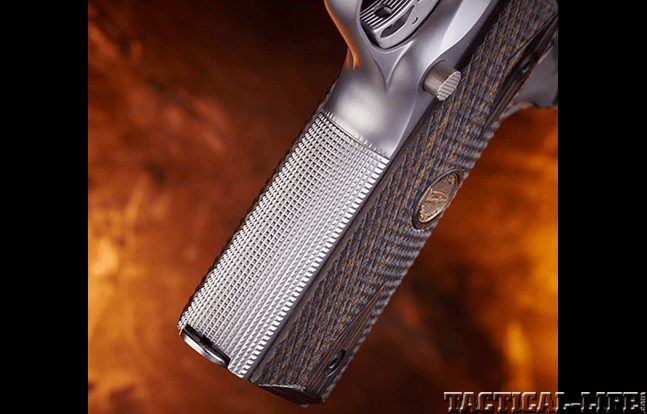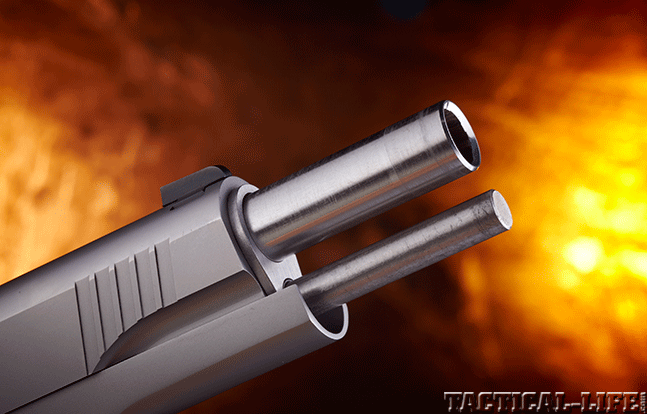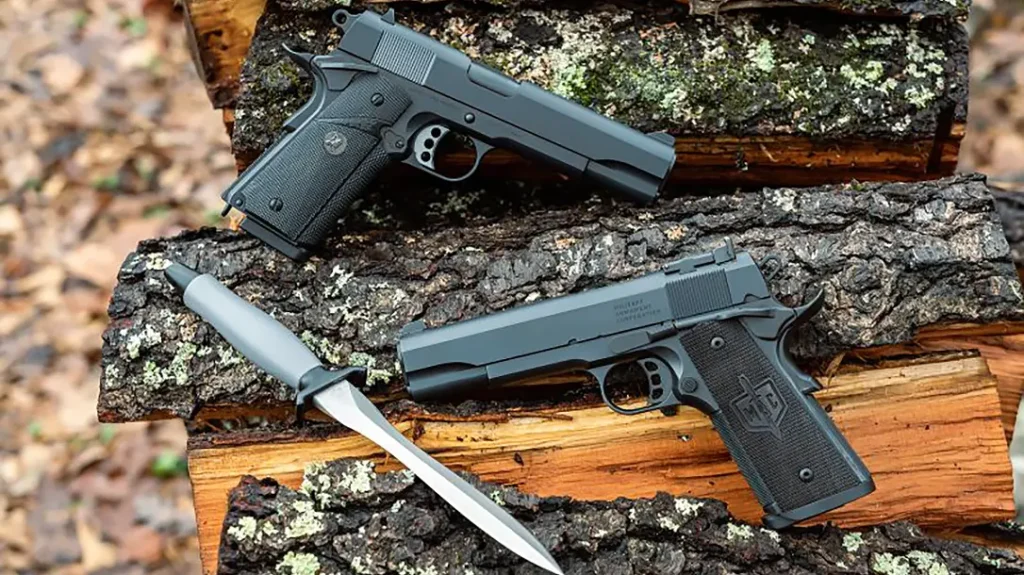It was de ja vu all over again when I stopped by the Kahr Arms/Auto-Ordnance booth at the 2013 NRA Show in Houston, Texas.
The subject of my recollection was the stainless steel Thompson Custom 1911. It wasn’t the first time I had seen it. Auto-Ordnance introduced this gun in 2008 but only made about 100 of them. It was discovered they were too expensive to manufacture and Kahr, Auto-Ordnance’s parent company, put the project on hold while it worked on manufacturing other in-demand guns already in its lineup.
It wasn’t until just recently that the folks at Kahr started work in earnest on this venture.
“We machined every part in that gun originally,” said Frank Harris, Kahr’s vice president of sales and marketing. “It was an incredibly expensive gun for us to produce, and we had to devote some time to study outside sources to see how we could get the price down to a more manageable figure.”
Advertisement — Continue Reading Below
Switching to metal-injection molded (MIM) parts for the Custom helped considerably in getting its suggested retail price down to just $813. Parts like the extended thumb safety, beavertail, slide stop and magazine release are manufactured using the MIM process rather than machining, and this resulted in significant cost savings. Nearly as dense as machined parts, the MIM parts require much less time to produce, have precise dimensions and require no hand-fitting.
Don’t get the wrong impression, though. Despite its budget price, the Auto-Ordnance Thompson Custom 1911 is not a budget-quality gun! Its price makes it one of the more attractive 1911s on the market today, and makes it perfect for entry-level action pistol shooting sports. Nearly all available 1911 aftermarket parts and accessories will work with the Thompson Custom 1911.
Advertisement — Continue Reading Below
Gun Details
Cosmetically, the Thompson Custom is a handsome pistol. It has a bead-blasted satin silver finish, and the laminated wood grips add a splash of green, brown and black to the gun. The grips, by the way, have an Auto-Ordnance medallion inset into the middle of their double-diamond cut checkering.
Advertisement — Continue Reading Below
Auto-Ordnance machines the stainless steel frame from a casting and its slide from a stainless steel billet. All machining is done in-house at the company’s plant in Worcester, Massachusetts, where exacting tolerances and quality control can be maintained.
The frame boasts 20-lines-per-inch, machine-cut checkering to provide the shooter with a secure firing grip. The left-side-only thumb safety is extended for easy disengagement and engagement. Though it blocks the sear securely, my test sample’s safety disengages too easily. I like my safeties to disengage as crisply as a trigger, and this problem was easily solved by stretching the plunger spring. The beavertail grip safety is well fit and has a hump to make sure the safety is disengaged even when shooting with the thumb on top of the thumb safety.
The magazine well is beveled for speedy reloads, and the magazine release is slightly extended to make engagement more positive. Auto-Ordnance outfits the pistol with a lightweight aluminum trigger that is adjustable for overtravel.
Advertisement — Continue Reading Below
The Thompson Custom’s slide is machined from stainless billet and features cocking serrations fore and aft. The Thompson bullet logo is engraved on the left slide flat. Sport shooters will appreciate the lowered and flared ejection port. The large opening allows empty cases to be thrown clear without any chance of hitting the port’s edges on the way out. Not only is the empty case thrown clear of the gun unimpeded, but the rollover flare also ensures the empty case remains dent free. That’s a great feature for those who reload their own ammunition!
Auto-Ordnance dovetails the slide for fixed sights. Its front sight is slightly ramped and is without a dot or insert, as is the low profile rear sight. Together they present a sharp, precise sight picture. A match-grade, stainless steel barrel with six-groove, left-hand, 1-in-16-inch-twist rifling is used. The barrel has a slightly larger diameter at the muzzle for a tight lock-up and easier unlocking during the cycling sequence. A dramatic concave crown is machined and polished on the barrel’s muzzle. The chamber mouth is chamfered from ear to ear and polished bright, as is the frame’s feed ramp, so that all bullet-nose profiles feed without a problem. Auto-Ordnance fits the bushing tightly to the barrel, but not so tight that it can’t be turned by hand. A full-length recoil spring guide rod is also used on the pistol. Its recoil spring is rated at 18 pounds, so the gun will work well with self-defense loads. The slide-to-frame fit of my sample was much better than expected and displayed no discernible horizontal or vertical play with the slide in battery.
The Thompson Custom 1911 possesses a Series80-type firing pin safety. The purpose of this safety is to prevent the firing pin from contacting the primer of a chambered round if the gun is dropped on its muzzle. The safety provides a mechanical block to the firing pin and ensures the gun won’t fire unless the trigger is purposefully pressed. It’s a proven system and works well in the Thompson Custom. The trigger pull on my test gun weighed in at about 5.5 pounds with some sloppy take-up. For sport use, this pull is a bit too heavy. But I’m certain that any savvy 1911 gunsmith could do some judicious polishing and honing to get the pull down to a more manageable weight.
Advertisement — Continue Reading Below
Range Time
Advertisement — Continue Reading Below
Despite the less-than-match-quality trigger, I had no problem shooting decent groups with the Thompson Custom 1911 pistol. My sights were well regulated, and I didn’t have to drift the rear sight for windage. Groups averaged a little more than 2 inches at 25 yards, and the pistol was 100-percent reliable. Five of the six loads I tested are considered “hot” defense ammunition. Four of the six were hollow-point rounds. All six of the loads fed and cycled perfectly. There were no stoppages during the testing of this pistol.
I took the Thompson Custom and a couple hundred rounds of reloaded ammunition out to the desert along with a steel target. Shooting at the steel plate at a distance of 15 yards using a Laser-Cast, 200-grain, round-nose bullet and enough of Winchester’s 231-grain powder to propel it at 850 feet per second (fps), I rang the steel with every shot, stopping only long enough to reload the magazines. Double-taps were quick and easy, and the gun was completely reliable. I use this reload for USPSA competition as well as practice, and even though it makes “major,” it’s very easy on the shooter and pistol.
Auto-Ordnance’s Thompson Custom 1911 is a good, solid 1911. While it would make a good defense pistol, I think it would also be an economical platform for beginning shooters for action pistol sports like USPSA and IDPA. The pistol can be upgraded as your skills improve. Auto-Ordnance builds its pistols to mil-spec dimensions, so if you’d like to use the gun for USPSA’s Limited 10 or Single-Stack competition you could, as an example, replace the magazine release with an Ed Brown mag release with an oversized button. You could also replace the slide release with a Wilson Combat Bullet-Proof release and also add the company’s Bullet-Proof Ambi Thumb Safety while you’re at it. For speedy reloads, you can replace the plastic mainspring housing with a Smith & Alexander Mag Guide, which acts as a funnel to guide your magazines into place. You may even want to replace the front sight with one of EGW’s fiber-optic front sights. Along with a trigger job, this setup should be able to take you to the highest echelons of competition without any problems.
Advertisement — Continue Reading Below
Make no mistake, the Auto-Ordnance Thompson Custom 1911 is a fine gun as is and will fill the needs of most shooters. It’s affordable, reliable and offers shooters a great degree of versatility.
For more information, visit auto-ordnance.com or call 508-795-3919.
